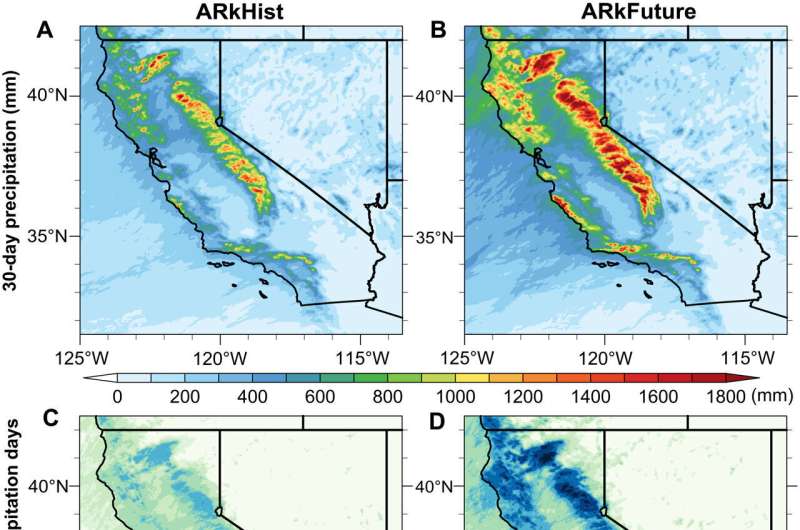August 15, 2022 report
Climate model suggests global warming has already doubled the risk of California megaflood

A pair of researchers, one with the Climate and Global Dynamics Laboratory at the National Center for Atmospheric Research in Boulder, Colorado, the other with the Institute of Environment and Sustainability at the University of California, Los Angeles, has found evidence suggesting that global warming is increasing the chances of much of California experiencing a megaflood in the coming decades. In their paper published in the journal Science Advances, Xingying Huang and Daniel Swain describe their analysis of the impact of global warming on the creation of atmospheric rivers over the Pacific Ocean and what it could mean to people living in California.
A megaflood, as its name implies, is not a regular flooding event—it is one that occurs over a large area and is much more severe than is normally seen, with the potential to devastate areas that are involved. California experienced a megaflood back in the winter of 1861/62. Water filled both the Sacramento and Joaquin valleys, and left cities such as Sacramento under ten feet of water. It took several months for the water to recede, leaving behind the bodies of over 4,000 people. Notably, at the time of the megaflood, only 500,000 people lived in California—today that number is closer to 39 million.
Prior research has shown that megafloods drenching California are a rare but regular occurrence. They happen when atmospheric conditions out over the Pacific Ocean come together to form atmospheric rivers, which are long narrow regions in the atmosphere that become highly saturated with moisture. When such rivers run into California's mountains, the water is released. In years past, it has been mostly released as snow, but now and in the future, the researchers note, it will come down as rain.
And that rain could last weeks, with the water filling up the valleys and surrounding areas. In the past, megafloods only happened in California every couple of hundred years. However, the researchers suggest that is likely to change to as often as once every 50 years, or even every 30 years, depending on how much the atmosphere heats up. That means it could happen any given winter, starting from now.
The researchers came to these conclusions after studying output from the Community Earth System Model Large Ensemble and comparing what it showed with high-resolution weather modeling. Together the two showed that global warming has already doubled the likelihood of a megaflood striking California any given winter. And that risk is growing as temperatures over the Pacific rise.
More information: Xingying Huang et al, Climate change is increasing the risk of a California megaflood, Science Advances (2022). DOI: 10.1126/sciadv.abq0995
Journal information: Science Advances
© 2022 Science X Network




















